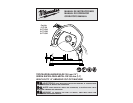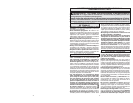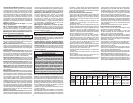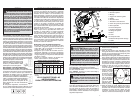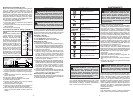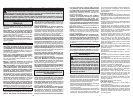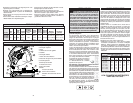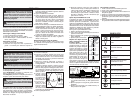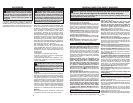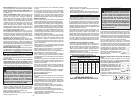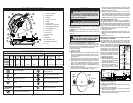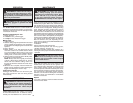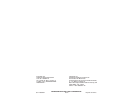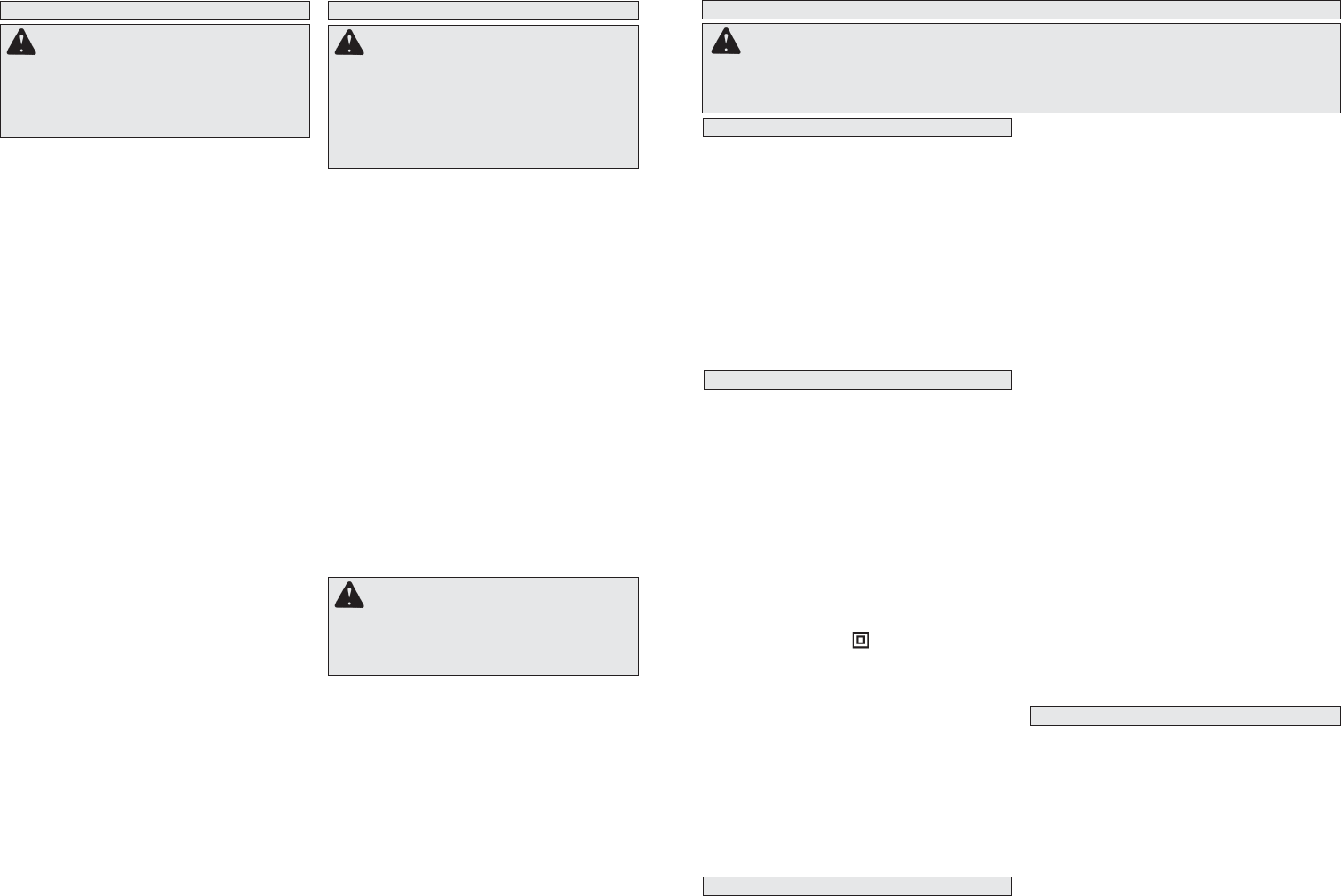
16
17
ACESSÓRIOS
Para obter uma listagem completa de acessórios,
consulte o catálogo de ferramentas elétricas da
MILWAUKEE ou visite www.milwaukeetool.com.
Para obter o catálogo, entre em contato com o seu
distribuidor local ou com um centro de serviços.
AVISO Para reduzir o risco de ferimen-
tos, sempre retire a ferramenta da tomada
antes de fi xar ou remover acessórios. Use
somente acessórios especifi camente reco-
mendados. Outros acessórios podem ser
perigosos.
AVISO Para reduzir o risco de ferimen-
tos, choques elétricos e danos à ferramenta,
nunca mergulhe a ferramenta em líquido nem
permita que líquidos entrem em contato com
a parte interna da ferramenta.
Limpeza
Limpe poeira e resíduos nos orifícios de ventilação.
Mantenha as alças limpas e livres de óleo ou graxa.
Use somente sabão suave e um lenço de limpeza
umedecido para limpar a ferramenta, pois certos
agentes de limpeza e solventes causam danos aos
plásticos e a outras peças revestidas. Veja alguns
exemplos desses agentes: gasolina, terebentina,
solventes, solventes de tinta, solventes de limpeza
à base de cloro, amônia e detergentes domésti-
cos que contêm amônia. Nunca use solventes
infl amáveis ou combustíveis perto das ferramentas.
Reparos
Se a ferramenta estiver danifi cada, envie-a para
a assistência técnica autorizada mais próxima.
MANUTENÇÃO
AVISO Para reduzir o risco de ferimen-
tos, sempre retire a ferramenta da tomada
antes de realizar qualquer atividade de ma-
nutenção. Nunca desmonte a ferramenta
ou tente fazer qualquer ajuste na fi ação do
sistema elétrico da ferramenta. Entre em con-
tato com uma assistência técnica autorizada
da MILWAUKEE para QUALQUER reparo.
Manutenção das ferramentas
Mantenha a ferramenta em boas condições ado-
tando um programa de manutenção regular. Antes
de utilizar a ferramenta, examine as condições
gerais. Verifi que as proteções, os botões, o con-
junto de fi ação e o cabo extensor para verifi car
se há danos. Verifi que se há parafusos soltos,
desalinhamento, travamento de peças móveis,
montagem inadequada, peças quebradas e outros
problemas que possam afetar a operação segura.
Se houver ruído ou vibração anormal, desligue
imediatamente a ferramenta e corrija o problema.
Não utilize uma ferramenta danifi cada. Ferramen-
tas danifi cadas “NÃO DEVEM SER USADAS” até
que sejam reparadas (ver “Reparos”).
Sob condições normais, não é necessário lubri-
fi car novamente até que as escovas do motor
sejam substituídas. Após seis meses ou um ano,
dependendo do uso, envie a ferramenta para "a
assistência técnica autorizada Milwaukee mais
próxima para:
• Lubrifi cação
• Verifi cação e substituição das escovas
• Inspeção mecânica e limpeza (engrenagens,
eixos, mancais, caixa, etc.)
• Inspeção elétrica (botão, cabo, blindagem, etc.)
• Teste para assegurar a operação mecânica e
elétrica adequada
GENERAL POWER TOOL SAFETY WARNINGS
WARNING READ ALL SAFETY WARNINGS AND ALL INSTRUCTIONS.
Failure to follow the warnings and instructions may result in electric shock, fi re and/or
serious injury. Save all warnings and instructions for future reference
The term "power tool" in the warnings refers to your mains-operated (corded) power tool or
battery-operated (cordless) power tool.
PERSONAL SAFETY
WORK AREA SAFETY
ELECTRICAL SAFETY
• Keep work area clean and well lit. Cluttered,
dark work areas invite accidents.
• Avoid dangerous environments. Do not use
your power tool in rain, damp or wet locations or in
the presence of explosive atmospheres (gaseous
fumes, dust or fl ammable materials). Remove
materials or debris that may be ignited by sparks.
• Keep bystanders away. Children and bystanders
should be kept at a safe distance from the work
area to avoid distracting the operator and contact-
ing the tool or extension cord.
• Protect others in the work area from debris such
as chips and sparks. Provide barriers or shields
as needed.
• Make workshop child proof with padlocks,
master switches, or by removing starter keys.
• Grounded tools must be plugged into an outlet
properly installed and grounded in accordance
with all codes and ordinances. Never remove
the grounding prong or modify the plug in any way.
Do not use any adaptor plugs. Check with a quali-
fi ed electrician if you are in doubt as to whether
the outlet is properly grounded. If the tool should
electrically malfunction or break down, grounding
provides a low resistance path to carry electricity
away from the user.
• Double insulated tools are equipped with a
polarized plug (one blade is wider than the
other). This plug will fi t in a polarized outlet
only one way. If the plug does not fi t fully in
the outlet, reverse the plug. If it still does not
fi t, contact a qualifi ed electrician to install a
polarized outlet. Do not change the plug in any
way. Double insulation
eliminates the need for
the three wire grounded power cord and grounded
power supply system.
• Guard against electric shock. Prevent body con-
tact with grounded surfaces such as pipes, radia-
tors, ranges and refrigerators. When making blind
or plunge cuts, always check the work area for
hidden wires or pipes. Hold your tool by insulated
nonmetal grasping surfaces. Use a Ground Fault
Circuit Interrupter (GFCI) to reduce shock hazards.
• Do not expose to rain or use in damp locations.
• Do not abuse the cord. Never use the cord to
carry the tools or pull the plug from an outlet.
Keep cord away form heat, oil, sharp edges
or moving parts. Replace damaged cords im-
mediately. Damaged cords increase the risk of
electric shock.
POWER TOOL USE AND CARE
limitations as well as potential hazards associated
with this type of tool.
• Stay alert, watch what you are doing, and
use common sense when operating a power
tool. Do not use tool while tired or under the
infl uence of drugs, alcohol, or medication. A
moment of inattention while operating power tools
may result in serious personal injury.
• Dress properly. Do not wear loose clothing or
jewelry. Wear a protective hair covering to contain
long hair. These may be caught in moving parts.
When working outdoors, wear rubber gloves and
insulated non-skid footwear. Keep hands and
gloves away from moving parts.
• Reduce the risk of unintentional starting. Be
sure your tool is turned off before plugging it in.
Do not use a tool if the power switch does not turn
the tool on and off. Do not carry a plugged-in tool
with your fi nger on the switch.
• Remove all adjusting keys and wrenches. Make
a habit of checking that adjusting keys, wrenches,
etc. are removed from the tool before turning it on.
• Do not overreach. Maintain control. Keep proper
footing and balance at all times. Maintain a fi rm
grip. Use extra care when using tool on ladders,
roofs, scaffolds, etc.
• Use safety equipment. Everyone in the work area
should wear safety goggles or glasses with side
shields complying with current safety standards.
Everyday eyeglasses only have impact resistant
lenses. They are not safety glasses. Wear hearing
protection during extended use and a dust mask
for dusty operations. Hard hats, face shields,
safety shoes, etc. should be used when specifi ed
or necessary. Keep a fi re extinguisher nearby.
• Keep guards in place and in working order.
• Never stand on tool. Serious injury could occur if
the tool is tipped or if the cutting tool is unintention-
ally contacted.
• Keep hands away from all cutting edges and
moving parts.
• Secure work. Use a clamp, vise or other practical
means to hold your work securely, freeing both
hands to control the tool.
• Do not force tool. Your tool will perform best at
the rate for which it was designed. Excessive force
only causes operator fatigue, increased wear and
reduced control.
• Use the right tool. Do not use a tool or attach-
ment to do a job for which it is not recommended.
For example, do not use a circular saw to cut tree
limbs or logs. Do not alter a tool.
• Unplug tool when it is not in use, before changing
accessories or performing recommended mainte-
nance.
• Know your power tool. Read this manual care-
fully to learn your power tool’s applications and



